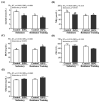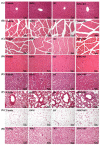Ergogenic Effects of Green Tea Combined with Isolated Soy Protein on Increasing Muscle Mass and Exercise Performance in Resistance-Trained Mice
- PMID: 34960099
- PMCID: PMC8704395
- DOI: 10.3390/nu13124547
Ergogenic Effects of Green Tea Combined with Isolated Soy Protein on Increasing Muscle Mass and Exercise Performance in Resistance-Trained Mice
Abstract
It is well known that supplementation with high protein after exercise can effectively promote muscle synthesis and repair, while green tea is rich in catechins that have antioxidant effects. We aimed to explore the effects of green tea combined with isolated soy protein on increase muscle mass in resistance-trained mice. A total of 32 male ICR mice (8-weeks old) were divided into four groups (n = 8/group), sedentary control group (SC), isolated soy protein with green tea group (ISPG), resistance training group (RT), isolated soy protein and green tea combine with resistance training group (ISPG + RT). All mice received control or ISPG by oral gavage for four consecutive weeks. Forelimb grip and exhaustive swimming time were used for exercise performance evaluation. In biochemical profile, we analyzed lactate, ammonia, blood urea nitrogen (BUN), and glucose and muscle damage index creatine kinase (CK) after exercise as biochemical parameters of exercise fatigue. The grip strength, muscular endurance, and exhaustive swimming time of the ISPG + RT group were significantly increased than other groups (p < 0.05), and also significantly decreased in serum lactate and ammonia levels (p < 0.05, respectively). The ISP + RT group was not only increased in quadriceps weight, (p < 0.05) but also decreased EFP (p < 0.05). We recommend using a 4-week supplementation with ISPG, combined with RT, to increase muscle mass, exercise performance, glycogen storage, and reduce fatigue biochemical parameters after exercise. The benefits of long-term supplementation or application to human supplementation can be further explored in the future.
Keywords: exercise performance; green tea; isolated soy protein; muscle mass; resistance training.
Conflict of interest statement
The authors declare no conflict of interest.
Figures








Similar articles
-
Isolated Soy Protein Supplementation and Exercise Improve Fatigue-Related Biomarker Levels and Bone Strength in Ovariectomized Mice.Nutrients. 2018 Nov 17;10(11):1792. doi: 10.3390/nu10111792. Nutrients. 2018. PMID: 30453643 Free PMC article.
-
Dehydroepiandrosterone Supplementation Combined with Whole-Body Vibration Training Affects Testosterone Level and Body Composition in Mice.Int J Med Sci. 2016 Sep 16;13(10):730-740. doi: 10.7150/ijms.16132. eCollection 2016. Int J Med Sci. 2016. PMID: 27766021 Free PMC article.
-
Sake Protein Supplementation Affects Exercise Performance and Biochemical Profiles in Power-Exercise-Trained Mice.Nutrients. 2016 Feb 20;8(2):106. doi: 10.3390/nu8020106. Nutrients. 2016. PMID: 26907336 Free PMC article.
-
Effects of green tea-derived natural products on resistance exercise training in sarcopenia: A retrospective narrative mini-review.J Food Drug Anal. 2023 Aug 31;31(3):381-386. doi: 10.38212/2224-6614.3470. J Food Drug Anal. 2023. PMID: 39666283 Free PMC article. Review.
-
Could nanotechnology improve exercise performance? Evidence from animal studies.Braz J Med Biol Res. 2024 Apr 19;57:e13360. doi: 10.1590/1414-431X2024e13360. eCollection 2024. Braz J Med Biol Res. 2024. PMID: 38656076 Free PMC article. Review.
Cited by
-
Soy Food Consumption Is Inversely Associated with Handgrip Strength: Results from the TCLSIH Cohort Study.Nutrients. 2023 Jan 12;15(2):391. doi: 10.3390/nu15020391. Nutrients. 2023. PMID: 36678260 Free PMC article.
-
Pea Peptide Supplementation in Conjunction With Resistance Exercise Promotes Gains in Muscle Mass and Strength.Front Nutr. 2022 Jul 7;9:878229. doi: 10.3389/fnut.2022.878229. eCollection 2022. Front Nutr. 2022. PMID: 35873424 Free PMC article.
-
Supplementation with Live and Heat-Treated Lacticaseibacillus paracasei NB23 Enhances Endurance and Attenuates Exercise-Induced Fatigue in Mice.Nutrients. 2025 Aug 7;17(15):2568. doi: 10.3390/nu17152568. Nutrients. 2025. PMID: 40806152 Free PMC article.
-
Exercise-induced vitamin D receptor and androgen receptor mediate inhibition of IL-6 and STAT3 in muscle.Biochem Biophys Rep. 2023 Dec 21;37:101621. doi: 10.1016/j.bbrep.2023.101621. eCollection 2024 Mar. Biochem Biophys Rep. 2023. PMID: 38205185 Free PMC article.
-
Lactobacillus plantarum PL-02 Supplementation Combined With Resistance Training Improved Muscle Mass, Force, and Exercise Performance in Mice.Front Nutr. 2022 Apr 27;9:896503. doi: 10.3389/fnut.2022.896503. eCollection 2022. Front Nutr. 2022. PMID: 35571912 Free PMC article.
References
MeSH terms
Substances
Grants and funding
LinkOut - more resources
Full Text Sources
Medical
Research Materials

